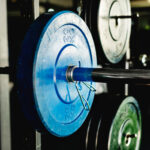Exercises You Should Be Doing: Band Assisted Scapular Upward Rotation
I’m obsessed with shoulder blades.
I know it’s an eyebrow raising comment to make and borderline weird, but it’s true.
I dig shoulder blades.
But before you click the “get me the hell off this page” button, let me clarify…
I believe most (not all) of people’s shoulder woes can be attributed to the shoulder blade(s) in some way, form, or fashion.
I also believe ghosts are real.
(Just kidding. But seriously, the shoulder blades are often the key to improving overall shoulder health).
👇👇👇👇👇

Copyright: Sebastian Kaulitzki
Get Those Scapulae Moving, Yo
Without going too far down the rabbit hole (and without a PubMed reference in site), I have been “caught” saying a time or two that 99% of the shoulder issues I come across – whether working with an overhead athlete or Martin from Tort-Law-R-Us1 – has it’s roots in what the shoulder blades are (or in most cases) are not doing.
For a myriad of reasons most of us have been programmed to think that “shoulder blades together AND down” is the end-all-be-all of shoulder health.
It works splendidly when 1) you’re working with someone who’s stuck in a more flexed/rounded/computer guy posture and/or 2) the goal is to lift as much weight as humanly possible.
I.e., good luck bench pressing (or even squatting/deadlifting) appreciable weight with shoulder blades that aren’t “set” in a more stable position.
That being said, too much of anything can have its inherent drawbacks.2
The “together and down” cue can lead to overactive lats and a more extension-based pattern where the shoulder blades get stuck or “cemented” together – making it all the more challenging for them to freely move about the rib cage (which they’re designed to do).
The scapulae are meant to move:
- Upward/downward rotation
- Protraction/retraction
- Anterior/posterior tilt
However, they often get “stuck” in a more downwardly rotated and retracted position from all the “down and back” cueing we’ve been inundated with.
One drill I have been using to help “un-glue” the shoulder blades is this one:
Band Assisted Scapular Upward Rotation
Who Did I Steal It From? – Dr. Michael Mash from his excellent Barbell Rehab course.
What Does It Do? This is such a simple drill to implement and works well with pretty much everyone. Except Orcs (for obvious reasons).
The pulldown trains scapular downward rotation and retraction, which is all well and good. I’m not a hater. It’s the reverse action, though, using the accentuated eccentric to emphasize scapular PROTRACTION and UPWARD rotation (with the assist from the band) that makes it a truly unique exercise to considering using.
This drill helps improve the full spectrum of scapular motion as well as to help gain “access” to overhead range of motion in general.
Key Coaching Cues: Attach a band to the top of a squat rack (or anything that doesn’t move) and sit directly underneath. From there, pull down as you normally would, but then SLOWLY resist the pull of the band as you allow it to pull your arm fully up overhead.
Juicy.


